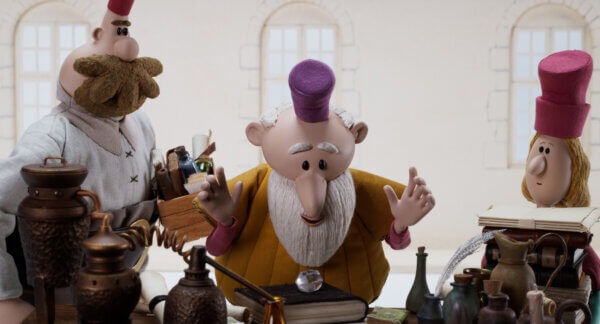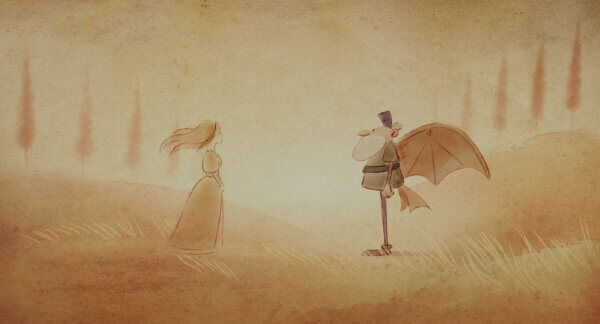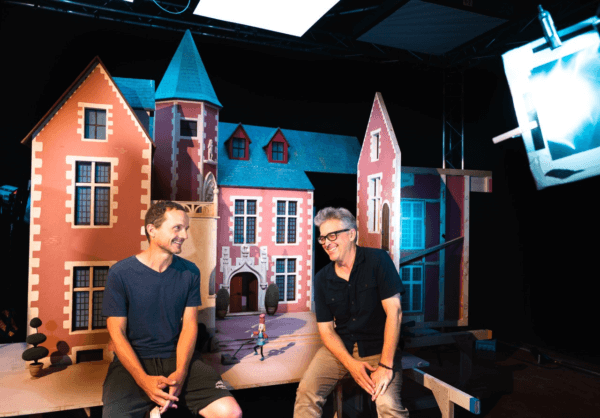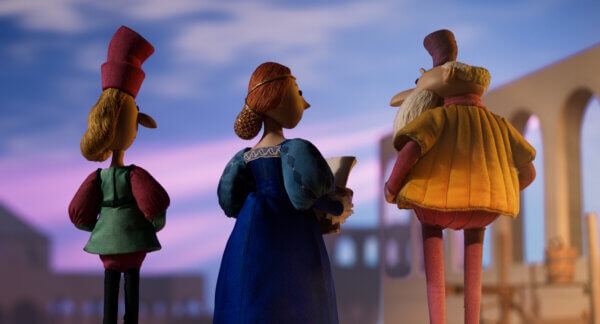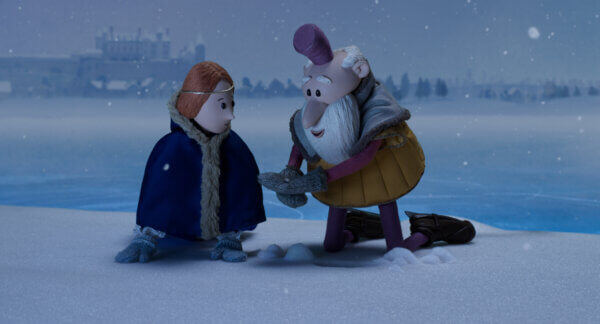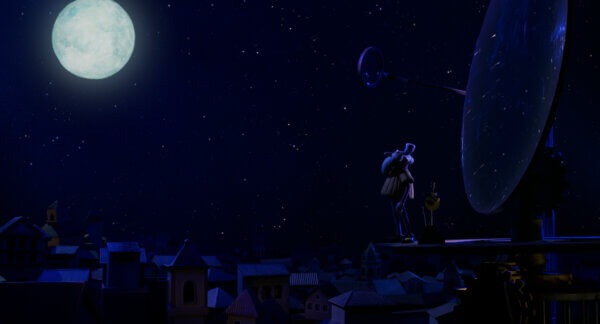The Inventor | Interview with director Jim Capobianco
The Inventor is a stop-motion film that focuses on the complex life of Leonardo da Vinci, probably one of the most well-known artists and inventors of all time. A genius who was a key figure in multiple scientific and visual art practices, da Vinci’s life and work could be told across multiple feature-length biopics. It is, however, his duality (and, ultimately, his humanity) that is at the centre of writer-director Jim Capobianco (Ratatouille, The Lion King)’s retelling of his life.
With his creativity shackled by his benefactors – firstly the pompous pope and then the powerful young French King Francis I – da Vinci finds an unlikely companion and kindred spirit in the King’s sister Marguerite (voiced by Daisy Ridley, Star Wars), a friend and muse to the artist and inventor in the last stages of his life. The film boasts an impressive cast, with British actor Stephen Fry as the titular Leonardo, Marion Cotillard as Louise de Savoy and Matt Berry as Pope Leo XI.
Growing from Capobianco’s previous 2D short film Leonardo, also about da Vinci, the feature makes use of puppet stop-motion characters – reminiscent of the classic American stop-motion works of Rankin and Bass – with 2D animation to capture a body of work spanning various innovations, detailed anatomical diagrams and world-renowned paintings among his other ventures. Created in collaboration with French-based Foliascope Studios and co-directed by the talented Pierre-Luc Granjon (Anatole’s Little Saucepan), a truly passionate team was brought together to create a poignant film full of warmth that seeks to present the necessity of creativity in the pursuit of knowledge and a better world for the many, rather than the wealthy few.
Ahead of next week’s UK theatrical release, Skwigly were able to speak to Jim Capobianco about the long journey that brought the story of Leonardo from the page to the big screen.
Leonardo da Vinci is probably one of the most famous inventors and artists in history. What was it about him, personally, that you felt connected to?
I think for me, it was because we know that he was this famous and amazing person who could do no wrong, who was interested in all these different things, a genius. I wanted to tell the other side of that story, the real human aspect of Leonardo da Vinci. Because he did question himself, and thought he failed. He did fail, sometimes with his ideas, and procrastinated and got distracted. He wrote grocery lists in his writings. You realise that this guy really existed, obviously, and was a real person. So that kind of aspect is really what I wanted to work around because, to me, that’s an interesting character that we can relate to. A character that is just a genius could be boring; not many of us are geniuses, so it’s a little hard to relate to them – and you can even hate them, in a way. So I really wanted to tell the warmer side of him and create that kind of a character.
You have a very impressive history in the industry, working on multiple, incredibly well-loved projects. Is this your first feature as a director, and what did you learn from taking on the role?
I’ve directed before, but nothing this long. And I did enjoy directing, I felt like I could do it well, and I thought I could just play in a world that’s a little bit longer. But I think more than anything, it was just the idea. I wanted to write the script in a longer format than other things I’ve done in my own work. Then one thing just led to another, and we made it. Someone needed to direct it, so I directed it, but I don’t know if I ever felt I had to be the one to direct. It was more due to being a filmmaker, having an idea for something that just needs to be made and seen and created. I think that was more of the impetus than just to direct.
A director born of necessity, rather than ego.
Exactly. Yeah, that’s very true.
This is also your first foray into stop-motion. There are obvious links between the engineering qualities of Leonardo’s work and stop-motion, but what made you select it as the primary technique in the film, and how did you find the process?
Yeah, so it’s exactly what you just said. I love stop-motion and I love drawn animation and I thought the film should be made with drawn animation for sure because of his drawings. But then I thought “Drawn animation is not as popular as it once was, with the people who hold the purse strings, and stop-motion keeps coming back, there’s always an interest in it. I’ve always loved it, I didn’t know how to do it but it felt very like Da Vinci to me as well, as you mentioned. So to me, those two forms together would be the perfect way to tell a story about Leonardo da Vinci. I figured, even though I didn’t know how stop-motion worked, I would find people who did.
It was very beneficial to have a co-director who knew stop motion, Pierre-Luc Granjon, who has made many stop-motion films, mostly short films, but also the longer form film The Four Seasons of Leone. I discovered and was inspired by his films before I knew him, from when I was looking at all the stop-motion films I could find. Then, when I started with Foliascope Studio in France, the head of the studio Ilan Urroz asked if I wanted to meet Pierre-Luc as he had worked for them and I thought that would be cool. Then he suggested that he may be a good co-director. We met and it was like two brothers who had been separated at birth! I was attracted to his sensibilities because I liked his films, and our sensibilities connected really well. He’s just such a wonderful human being that it worked out perfectly, because I got to learn from a master and I could concentrate on making sure the story was told properly. So it was a perfect combination of people.
Within stop-motion, there are so many different processes and different techniques. Did choosing a more Rankin and Bass aesthetic for the film come directly from the short or any of the people you worked with?
It came from me, most of all. I sent those films over to them and I think it was the first time the French team had seen them, as they’re very American. I don’t know if their films get out there much beyond America, so I think that opened their eyes a bit. I think they also hoped that I didn’t want it to look as crude. I like dot-eyed characters, I think there’s something cute about them; I designed Leonardo for the short that way, so if this film was an outgrowth from the short then he would have to look like that Leonardo as well.
I think that my design sensibility lends itself to those older Rankin and Bass-looking films. I just love the simplicity of design in them and I think that’s just what I gravitate toward. I was also inspired by Jiří Trnka, Karel Zeman, George Pal’s work and also more modern studios like Screen Novelties here in the US who do amazing work and are inspired by all those historical stop-motion people. Their work was also inspiring to me because they handle stop-motion in a way that’s a little bit more like 2D animation, using very broad caricature movement and acting, which is very hard to do in stop-motion. They’re good friends, too. So I also introduced the Europeans to their work, Elf: Buddy’s Musical Christmas especially.
Was there anyone else who greatly aided in the film’s production?
Our line producer, actually, Kat Alioshin who worked on Nightmare Before Christmas and Coraline, and all these very accomplished American stop-motion films. She brought her production acumen to Foliascope, which needed to be really structured and planned-out because of the budget and how ambitious the film we were making was. So she brought that way of thinking to the project. Kat and Pierre-Luc, together, really made the film run so smoothly, and we didn’t go over budget or time, because of their planning – it was perfect. She’s also really funny and fun, so she brought a lot of levity to the studio, and people just loved her. She really understands artists and I think that’s really important.
Getting an original animated feature off the ground is no mean feat these days. Can you tell me a little bit about the journey from the original short to the feature?
After the short, I thought maybe I could make a feature film around Leonardo. And I thought maybe these three years at the end of his life would be interesting, to take a piece of his life rather than his whole life story. Originally the story was going to be focused on Leonardo’s support of the king, a kind of a King Arthur and Merlin story, but we’ve kind of seen that before and it wasn’t going anywhere for me. Then I learned about Marguerite, the king’s sister, who was this amazing Renaissance woman, and I thought “Well, maybe Marguerite learned more from Leonardo da Vinci than the king did”, which gave me this story to tell. From that point, I wrote the script and then I met Robert Rippberger, who became my co-producer. He was a real go-getter and started to run around looking for money. We went everywhere – LA, Canada, Ireland, Luxembourg, Belgium and Italy, for a while, looking for money to support the film. Over the ten years it took to finally pull everything together, we just kept banging on doors and in about 2016 we made a teaser trailer to show what it would look like, which helped serve as a showcase of what it would look like; these are the sensibilities that we’ll have, how we will integrate 2D and stop-motion, how we will deal with the dissection in the film. These were all things that we were running up against. It was a lot better to show than tell.
The trailer was made in 2016, just as I left Pixar. Then up until 2020 – so for four more years – we were still running around with it. During this time I was still developing the film, I was writing the script, storyboarding it, bringing artists in when I could, to help design and create concept boards. Because with each new element, we could add them into the presentation and say “Look at this beautiful piece of art” and wow people with the project. Eventually we connected with Ilan Urroz, who loved the project so much and wanted to make it happen. With a French production studio, we were able to pitch at Cartoon Movie, which is a forum for pitching where you can get producers, distributors and sales agents. So we pitched the film and it did well. I had to tell them all that I had French blood in me, having made Ratatouille and all the other projects I’ve done, because I was the first American to pitch there, and people were wondering why some Pixar guy was pitching at there European animation conference? So it went really well and that got us going. It was a long road.
I understand that the music was a slightly late addition to the film, could you tell me a little about your collaboration with Alex Mandel, bringing those musical elements into the film and how you felt that helped the characters develop in the film?
So Alex and I know each other from the short film I made Your Friend The Rat, that I brought him on to help me with. I knew he was a very versatile composer. He came on to the film very early on when I was developing the script. I would give him ideas and he’d start working on the themes for the film. He did the score for the teaser trailer we did as well. But what happened was, there’s a scene in the film where Leonardo builds his workshop, when he arrives in Clos Lucé, his home in France. I didn’t want to just see people moving in boxes of paint materials, paintings and contraptions. I thought it’d be interesting if he built the workshop around him and it assembled around him, what with it being stop-motion, you can have things just pop on and appear, which would be really fun. It also felt musical to me, it felt like a song moment, which I had mentioned to Alex. So he created a song for it which was really fun. So we had this one song, and then somebody who saw an earlier version said “How can you have one song at the end of the first act? It’s gonna come out of nowhere. You should have something in the beginning to establish that there will be songs in this film”.
One thing led to another and we started adding songs to the film. In a way it helped bring out these character moments. I don’t think of the film as a musical because it grew out differently. It’s more like the original Pinocchio film; I never think of that as a musical, but it has songs in it. I think that’s the way I look at this film, because it doesn’t follow the structure of a musical, we just thought “Let’s put a song here and they should have a song there”. We also had Marion Cotillard in the film, so we felt she should sing something, so we gave her the En garde song. So that’s how we ended up having songs in the film.
The Inventor will be released exclusively in Vue cinemas from 8th March in the UK.


